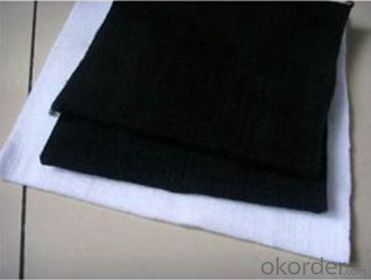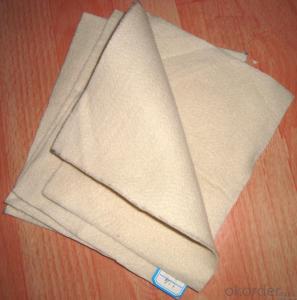Gator Fabric Geotextile - Filament Non-Woven Geotextile for Reinforcement and Drainage from CNBM
- Loading Port:
- China main port
- Payment Terms:
- TT OR LC
- Min Order Qty:
- 3000 g/m²
- Supply Capability:
- 1000000 g/m²/month
OKorder Service Pledge
OKorder Financial Service
You Might Also Like
Specification


1) Weight / Mass: 100g/m2-800g/m2
2) Width: Within 6 m (1m-6m)
3) Length: 50m-100m/roll (as request)
4) Material: PP / PET
5) Color: Black , white , grey and other color
6) Certificate: CE/ISO9001 , ISO14001
7) Manufacturing method: nonwoven / woven
8) The Biggest geotextile manufacturer/factory in China for many years
Geotextile Type:Non-Woven Geotextiles
1.On a regular basis or as per your request,we entrust national testing agencies to conduct quality inspections
2. Strictly in accordance with the ISO9001-2008 international quality system standard,we monitor and manage the whole process throughout production,quality testing,and measurement to ensure product quality
3. For quality-related construction delay or substandard construction(except for damage or losses due to customer’s responsibility or irresistible natural disasters),we have refunding,replacement,and repair services.We will respond to customers’ feedbacks on quality issues within 24 hours.
After-sales service
1.In order to provide customers with comprehensive technical support,we will provide technical and other related information upon request in a timely manner.
2.In required,we will appoint specialized technicians to the construction site to give technical trainings to construction people,and offer technical guidance throughout the whole construction process.
3.For damage due to shipment and delivery,after we receive the complaint,we will check the issure through provided pictures and videos.If our responsibility is confirmed,we wil offer free replacement.
4.When the construction is completed,as your request,our technical staff may participate in the final acceptance.
FAQ:
Q: What kind of payments does jenor support?
A: T/T, L/C, Cash are accepted.
Q: Do you charge for the samples?
A: Accordeing to our company policy, the samples are free, we only charge the freight fee. And we will return the freight fee during the next order.
Q: Can you produce according to customers' design?
A: Sure, we are professional manufacturer, OEM and ODM are both welcome.
Q: Do you have other products?
A: Yes, please check the pictures:
- Q: In the river within the construction of flexible piping can use geotextile to do anti-floating measures
- Yes, I am specialized in producing the installation
- Q: How much is the price of anti-geotextile?
- In the actual engineering procurement, generally between the two geotextiles need about> 250px lap, so the procurement is usually based on the actual area plus 15% to 20% loss. Hongxiang new material Li Qian geotextile price is also required according to the specific needs of the project to specify the model, the specific offer.
- Q: Textile geotextile lap length how much
- Lap width is generally 10-15cm
- Q: Do you need to cover the geotextile?
- Do not need, bathroom waterproof can choose a professional kitchen and toilet waterproof paste, or K11 waterproof slurry, water and electricity transformation, as long as the direct brushing on the base surface can be done until the waterproof layer can do 48 to 72 hours Of the closed water experiment, no problems can be posted after the brick.
- Q: How do geotextiles help in preventing the loss of fine particles in filter layers?
- Geotextiles help in preventing the loss of fine particles in filter layers by acting as a barrier that allows water to pass through while retaining the fine particles. They provide a stable and durable structure that supports the filter layer, preventing it from dislodging or eroding. This ensures that the filter layer remains intact and effectively filters out the fine particles, reducing their loss and improving the overall performance and longevity of the filtration system.
- Q: Can geotextiles be used for reinforcement of earthen dams?
- Yes, geotextiles can be used for the reinforcement of earthen dams. Geotextiles are commonly employed in dam construction projects to enhance the stability, strength, and erosion resistance of earthen embankments. They act as a barrier, preventing the loss of soil particles while still allowing for water drainage, thereby improving the overall performance and longevity of the dam.
- Q: What are the specifications for geotextiles in gas venting projects?
- The specifications for geotextiles in gas venting projects typically involve requirements such as high permeability, durability, and chemical resistance. They should have a minimum permeability to allow gas to pass through while preventing the migration of fine particles. Additionally, they should be able to withstand the harsh environmental conditions, including exposure to chemicals and UV radiation. Other specifications may include strength, puncture resistance, and compatibility with the surrounding soil or materials used in the gas venting system.
- Q: Can geotextiles be used in oil and gas industry applications?
- Yes, geotextiles can be used in oil and gas industry applications. Geotextiles are commonly used for erosion control, soil stabilization, and filtration purposes in various industries, including the oil and gas industry. They can be used in applications such as pipeline construction, drilling operations, and containment systems. Geotextiles help to prevent soil erosion, provide stability for construction sites, and aid in filtration and separation of materials in oil and gas operations.
- Q: It is good to cover the geotextile
- What are you breeding? Tarpaulin can be waterproof and waterproof, do not know if you have not seen geotextiles, geotextiles and silk cotton coat inside the like, light, there is a certain role in insulation, but not waterproof. Hope to help you
Send your message to us
Gator Fabric Geotextile - Filament Non-Woven Geotextile for Reinforcement and Drainage from CNBM
- Loading Port:
- China main port
- Payment Terms:
- TT OR LC
- Min Order Qty:
- 3000 g/m²
- Supply Capability:
- 1000000 g/m²/month
OKorder Service Pledge
OKorder Financial Service
Similar products
Hot products
Hot Searches
Related keywords


































